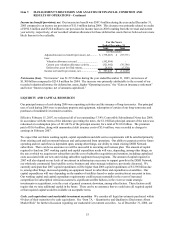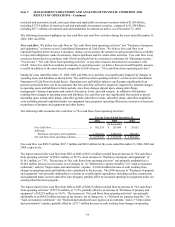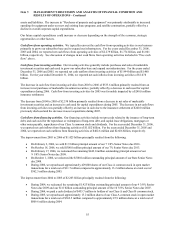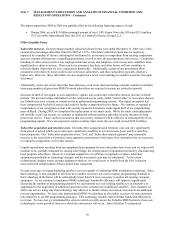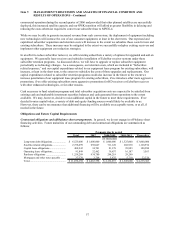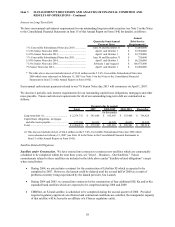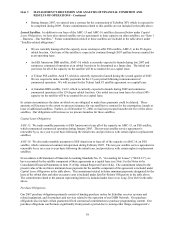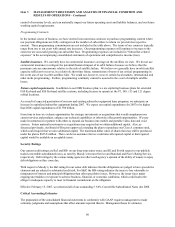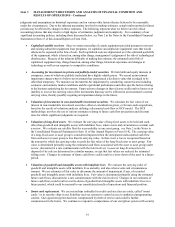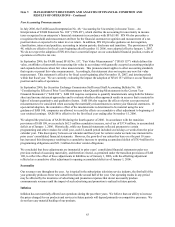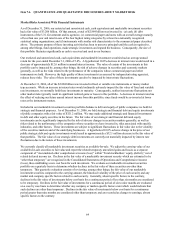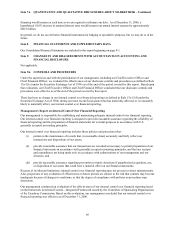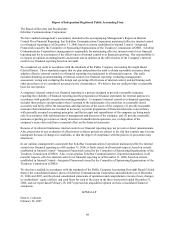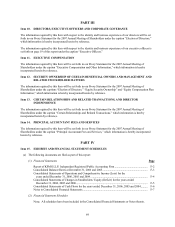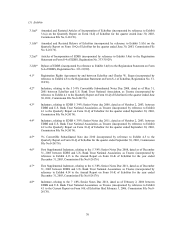Dish Network 2006 Annual Report Download - page 73
Download and view the complete annual report
Please find page 73 of the 2006 Dish Network annual report below. You can navigate through the pages in the report by either clicking on the pages listed below, or by using the keyword search tool below to find specific information within the annual report.Item 7. MANAGEMENT’S DISCUSSION AND ANALYSIS OF FINANCIAL CONDITION AND
RESULTS OF OPERATIONS – Continued
63
New Accounting Pronouncements
In July 2006, the FASB issued Interpretation No. 48, “Accounting for Uncertainty in Income Taxes – An
Interpretation of FASB Statement No. 109” (“FIN 48”), which clarifies the accounting for uncertainty in income
taxes recognized in an enterprise’s financial statements in accordance with SFAS 109. FIN 48 also prescribes a
recognition threshold and measurement attribute for the financial statement recognition and measurement of a tax
position taken or expected to be taken in a tax return. In addition, FIN 48 provides guidance on derecognition,
classification, interest and penalties, accounting in interim periods, disclosure and transition. The provisions of FIN
48, which are effective for fiscal years beginning after December 15, 2006, were adopted effective January 1, 2007.
We do not expect the adoption of FIN 48 to have a material impact on our consolidated financial position, results of
operations or effective tax rate.
In September 2006, the FASB issued SFAS No. 157, “Fair Value Measurements” (“SFAS 157”) which defines fair
value, establishes a framework for measuring fair value in accordance with generally accepted accounting principles
and expands disclosures about fair value measurements. This pronouncement applies to other accounting standards
that require or permit fair value measurements. Accordingly, this statement does not require any new fair value
measurement. This statement is effective for fiscal years beginning after November 15, 2007, and interim periods
within that fiscal year. We are currently evaluating the impact the adoption of SFAS 157 will have on our financial
position and results of operations.
In September 2006, the Securities Exchange Commission Staff issued Staff Accounting Bulletin No. 108,
“Considering the Effects of Prior Year Misstatements when Quantifying Misstatements in the Current Year
Financial Statements” (“SAB 108”). SAB 108 requires companies to quantify misstatements using both the balance
sheet and income statement approaches and to evaluate whether either approach results in an error that is material in
light of relevant quantitative and qualitative factors. SAB 108 also requires the effects of prior year uncorrected
misstatements to be considered when assessing the materiality misstatements in current-year financial statements. If
upon initial adoption, the cumulative effect of the misstatements is determined to be material using the new
guidance of SAB 108, companies are allowed to record the effects as a cumulative effect adjustment to beginning of
year retained earnings. SAB 108 is effective for the first fiscal year ending after November 15, 2006.
We adopted the provisions of SAB 108 during the fourth quarter of 2006. In accordance with the transition
provisions of SAB 108, we recorded a $62.3 million cumulative increase, net of tax of $37.4 million, to accumulated
deficit as of January 1, 2006. Historically, while our financial statements reflected payments to certain
programming and other vendors for a full year, each 12-month period included several days or weeks from the prior
calendar year. This discrepancy between our calendar and fiscal year for certain vendor accruals was immaterial to
prior years’ consolidated financial statements. However, the growth of our subscriber base over the past 10 years
has increased this discrepancy resulting in a cumulative increase to opening accumulated deficit of $78.4 million for
programming obligations and $21.3 million for other vendor obligations.
We concluded that these adjustments are immaterial to prior years’ consolidated financial statements under our
previous method of assessing materiality, and therefore elected, as permitted under the transition provisions of SAB
108, to reflect the effect of these adjustments in liabilities as of January 1, 2006, with the offsetting adjustment
reflected as a cumulative effect adjustment to opening accumulated deficit as of January 1, 2006.
Seasonality
Our revenues vary throughout the year. As is typical in the subscription television service industry, the first half of the
year generally produces fewer new subscribers than the second half of the year. Our operating results in any period
may be affected by the incurrence of advertising and promotion expenses that do not necessarily produce
commensurate revenues until the impact of such advertising and promotion is realized in future periods.
Inflation
Inflation has not materially affected our operations during the past three years. We believe that our ability to increase
the prices charged for our products and services in future periods will depend primarily on competitive pressures. We
do not have any material backlog of our products.


